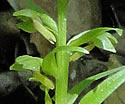Coeloglossum viride (Long-bract Frog Orchid)
| Also known as: | Long-bracted Orchid |
|---|---|
| Genus: | Coeloglossum |
| Family: | Orchidaceae (Orchid) |
| Life cycle: | perennial |
| Origin: | native |
| Habitat: | part shade, shade; moist woods, thickets, meadows, bogs |
| Bloom season: | May - August |
| Plant height: | 6 to 20 inches |
| Wetland Indicator Status: | GP: FACU MW: FAC NCNE: FAC |
| MN county distribution (click map to enlarge): |  |
| National distribution (click map to enlarge): |  |
Pick an image for a larger view. See the glossary for icon descriptions.
Detailed Information
Flower: 


![[photo of flowers]](/udata/r9ndp23q/green/long-bracted-orchid_0601_101544-t.jpg) Spike-like raceme of 11 to 76 irregular flowers at the top of the stem. Flowers are about 2/3 inch long from tip of upper hood to tip of lower petal, green or tinged purple. The upper sepal is oval to round and with the smaller, more crescent shaped lateral petals and sepals forming a hood. The lower petal is more yellowish, long, almost rectangular, hanging down with a notch at the tip, forming 2 lobes. The inconspicuous spur is a small round ball behind the base of the lower lip.
Spike-like raceme of 11 to 76 irregular flowers at the top of the stem. Flowers are about 2/3 inch long from tip of upper hood to tip of lower petal, green or tinged purple. The upper sepal is oval to round and with the smaller, more crescent shaped lateral petals and sepals forming a hood. The lower petal is more yellowish, long, almost rectangular, hanging down with a notch at the tip, forming 2 lobes. The inconspicuous spur is a small round ball behind the base of the lower lip.
![[photo of bracts]](/udata/r9ndp23q/pd/coeloglossum-viride-20-t.jpg) The leaf-like flower bracts are conspicuous and lance-like to linear. Lower bracts can be 2 to 3 times the length of the flowers, becoming progressively smaller towards the end of the spike.
The leaf-like flower bracts are conspicuous and lance-like to linear. Lower bracts can be 2 to 3 times the length of the flowers, becoming progressively smaller towards the end of the spike.
Leaves and stem: 

![[photo of leaves]](/udata/r9ndp23q/green/long-bracted-orchid_0601_103121-t.jpg) Leaves are 2 to 5 inches long, 1½ to 2½ inches wide, toothless and hairless, elliptic to oblong with a blunt point, sheathing the stem at the base, becoming smaller and more lance shaped up the stem, 2 to 6 leaves per stem. Stems are unbranched and smooth, with a few sheathes near the base below the leaves.
Leaves are 2 to 5 inches long, 1½ to 2½ inches wide, toothless and hairless, elliptic to oblong with a blunt point, sheathing the stem at the base, becoming smaller and more lance shaped up the stem, 2 to 6 leaves per stem. Stems are unbranched and smooth, with a few sheathes near the base below the leaves.
Notes:
This is one of the most common orchids in the world. Records of Long-bract Frog Orchid are widespread across Minnesota but it is most prevalent in upland hardwood forest along the tension zone between the western prairie and eastern forest, often on steep slopes. Development and land use has extirpated it from many of its historical locations so it is now much more rare than the distribution map indicates. This species was formerly known as Dactylorhiza viridis or Coeloglossum viride var. virescens. Flora of North America, our definitive reference, has dropped the var. designation. It most closely resembles Tuberculed Rein Orchid (Platanthera flava var. herbiola), which has a lower lip with a rounded tip and a protrusion near the base, and shorter bracts.
Native Plant Nurseries, Restoration and Landscaping Services ↓
More photos
Photos by K. Chayka and Peter M. Dziuk taken in Aitkin County.
Comments
Have you seen this plant in Minnesota, or have any other comments about it?
on: 2014-07-15 04:05:10
Found on an East Facing slope in a rich uplands hardwood forest in the Minnesota River Valley
on: 2017-06-21 18:45:37
They grow along the road leading to Sucker Creek, in Iron Springs Bog, SNA.







 Long-bract Frog Orchid plant
Long-bract Frog Orchid plant